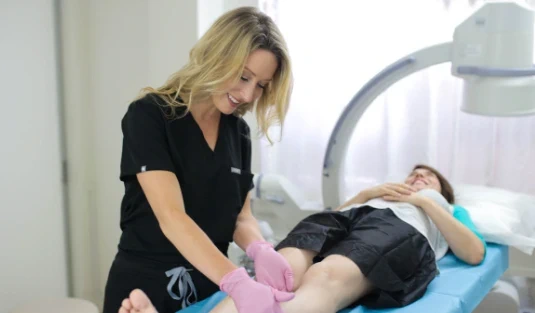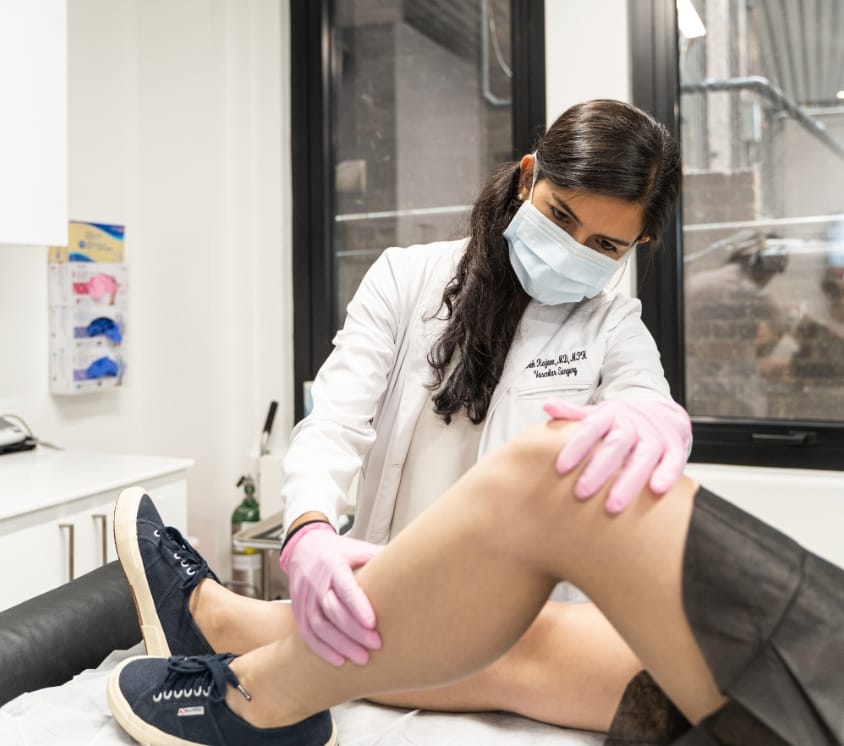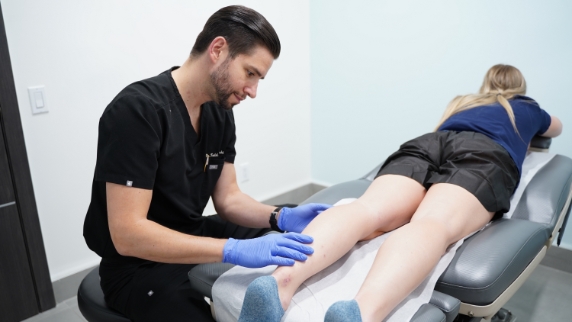Vein issues are more prevalent than artery diseases and they increase with age. The majority of adult population in the U.S has a given type of leg vein disease. A vein issue can worsen to a point of causing disability and inability to go to work. That’s why victims are advised to meet one of the best vein doctors early; their symptoms are diagnosed and treated before they become harder to deal with. There are usually three types of vein problems that any varicose vein doctor San Diego treats on a regular basis. These include: varicose veins, chronic venous insufficiency and deep vein thrombosis. Each problem is discussed in depth as shown below:
1. Varicose veins
These are veins located closer to the skin surface and mostly in the legs. They usually appear swollen and knotted and have a bluish color. These bulging veins generally develop on the inside of the thigh or calf and are both embarrassing and painful to live with. Vein doctors treat more women than men when it comes to varicose veins. In the United States only, it is estimated that twenty to twenty-five million people are victims of varicose veins.
Also known as varicosities, bulging leg veins develop after the one-way valves within them fail to function well. Instead of letting all blood to pass and flow back to the heart, faulty valves tend to leak. This enables some of the blood to flow backward and pool in the leg veins. As more and more blood gathers, pressure mounts and causes the vein walls to dilate, twist and thicken—varicose veins. Backward flow of blood because of weakened veins or damaged valves is referred to us reflux. People who have this problem are said to have a venous reflux disease, also called venous insufficiency.
Real varicose veins are huge veins of three millimeters in diameter and can even be larger than this. Although people are able to live with this problem, it is still advisable to see a varicose veins doctor San Diego area as early as you can. Otherwise, these can worsen and complicate treatment.
How to know you have varicose veins
Some people do not even have to see one of the leading vein doctors to know they have varicosities. The condition tends to cause symptoms that are quite easy to detect. These signs include the following:
- Skin rashes and complexion changes
- Burning pain or heavy ache in legs
- Leg pain that gets worse when one sits down or stands up for many hours
- Leg swelling especially around the ankles
- Leg sores or ulcers
If varicosities go untreated, they can trigger severe leg swelling, venous eczema and leg ulcers that refuse to heal quickly. You are likely to see the above-mentioned symptoms if you are a woman, obese, pregnant, older, or genetically predisposed. People who have a leg injury or those taking hormones to prevent conception or alleviate menopausal side effects can be affected by varicose veins. Moreover, those who suffer from poor blood circulation because of poor work postures can develop varicose veins and require the assistance of vein doctors.
How are these diagnosed?
A good varicose veins doctor San Diego will use three techniques to determine if you have varicosities. First, they will just observe your legs when you stand up or sit down with your legs hanging. These positions enable the veins to stick out strongly, ensuring easy detection. The next technique they will use is Duplex ultrasound. This test assesses the blood flow and structure of one’s leg veins; it is so reliable. To confirm their result, vein doctors also carry out a MRV (magnetic resonance venography) test.
This one generates comprehensive 3-D images of the veins. Done using magnets, radiofrequencies and a computer to display the images, a MRV test is extremely reliable. It might include the use of a given contrast dye that enables the varicose veins doctor San Diego to view the inside of the veins.
How doctors treat varicosities
If the tests above turn out positive, most vein doctors will not hesitate to start treatment. Basically, this will encompass three things first: exercise, leg elevation and elastic compression. All the three are recommended because they boost blood flow and relieve pain. While compression stockings can feel a little uncomfortable, they squeeze the toes, ankles and calves. The additional pressure they exert helps to keep blood from refluxing and pooling in veins.
If the above-mentioned three techniques fail, a varicose veins doctor San Diego will go ahead with medical treatment. This entails three processes that are minimally invasive:
- Sclerotherapy – Here, veins are injected with a chemical solution or foam that is able to permanently block and scar a vein. The process stops blood from ever flowing through the injected veins.
- Radiofrequency ablation – Simply known as RFA, this technique involves insertion of a catheter and device that releases radio waves energy withing the greater saphenous vein. This method is reserved for large varicose veins that cannot respond to other simpler methods. It entails an anesthesia shot to reduce pain when incisions are being made and when a catheter is being placed and removed from the GSV.
- Endovenous laser ablation – This type of therapy is the least invasive of all and the one that causes the fewest side effects. Like RFA, EVLA is all about destroying the problematic vein with heat. In this case, heat is released by a strong beam of light released by the laser device.
Ambulatory phlebectomy – In this case vein doctors remove varicose veins via small incisions made in the skin. Ambulatory phlebectomy is less invasive than real surgery and the recovery is quick. Sometimes it is combined with EVLA or RFA.
2. Chronic venous insufficiency
This is another vein problem affecting both genders. CVI happens when leg veins stop pumping blood back to the heart in an effective manner. Venous insufficiency symptoms begin to emerge when one develops a reflux problem and varicose veins. If left untreated, this reflux disease progresses to a point where it becomes chronic. As well as varicose veins, CVI tends to occur when the blood vessels are blocked by a blood clot. According to vein doctors, any person who has a history of blood clots or DVT can develop CVI. That’s because clots tend to block venous blood flow and damage the valves in the vein.
Chronic venous insufficiency Symptoms
This disease has the following signs and if you see them, the best action to take immediately is to visit the most dependable varicose veins doctor San Diego.
- Legs and ankles swelling is usually one of the earliest signs of this disease
- Heaviness, tightness and restlessness sensations in the legs
- Pain and fatigue in the legs
- Discoloration of the skin
- Varicose veins
- Venous eczema, a condition that causes the skin to become tough, dry, flaky and itchy
- Venous leg ulcers. These are open wounds that can produce a lot of pain and don’t heal easily.
Chronic venous insufficiency has the same risk factors as varicose veins. Additionally, if you just had a major leg or foot surgery, or have a broken bone, you are likely to develop CVI as well.
Diagnosis
CVI is diagnosed the same way that varicose veins are. Vein doctors ask about the symptoms and history of the disease in one’s family. Then, they go on to perform duplex ultrasound and MRV tests. If it is proven that you have CVI, the necessary treatment steps are immediately taken.
Treatment
Similar to varicose veins, your varicose veins doctor San Diego will ask you to do three things without missing: exercise, elevation of legs and wearing compression stockings. Exercise enhances blood flow and builds stronger leg muscles that promote pumping of blood back to the heart. Elevation of legs is important because it brings about quick relieve from pain caused by the swelling. Legs should be raised above the level of one’s heart about four times per day. Ensure that you keep them raised for about fifteen minutes each time.
When sitting down for a long time, stand up and move about your work station every half of an hour. You can also try to bend your legs severally as this can increase blood circulation. When standing up, take a seat severally, move about often and find a stool to step on occasionally with each leg to reduce strain and boost blood flow. As for wearing compression stockings, it’s truly important to do so to increase tightness and increase blood circulation. It goes without saying that doing the above three things improves venous insufficiency symptoms.
Nevertheless, none of them can heal the underlying disease as it needs proper medical attention. Your varicose veins doctor San Diego will therefore offer you real treatment depending on your symptoms. If there are ulcers, more medical care and help will be granted as these are hard to heal and very uncomfortable to have. Like when treating varicosities, vein doctors provide less invasive options. These are the same ones we described in the varicose veins section, but sclerotherapy may be applied when treating CVI, yes, but RFA and EVLA are mostly preferred. In addition to the above, the vein doctors offer other techniques:
- Angioplasty and stent placement – This technique is used when a blocked vein is the source of CVI symptoms.
- Vein stripping surgery – This is when the greater saphenous vein (GSV) is removed completely through a tiny cut that is made in the groin and another one at the knee. Surgery might also include vein repair or vein transplant; the varicose vein doctor San Diego might as well perform sub-fascial endoscopic perforator surgery.
Generally, treatment for CVI will be offered based on the patient’s age, overall medical history, severity of the disease, and their level of tolerance for certain drugs and procedures.
3. Deep vein thrombosis
Simply called DVT, this problem happens when a blood clot (thrombus) forms in a large deep vein found in the leg or pelvic area. If this clot frees itself and travels to the lung, it can lead to a deadly disease called pulmonary embolism (PE). DVT affects about two million people in the U.S every year. If the inner lining of the vein gets inflamed or if a person’s blood tends to clot too easily, DVT can be the outcome. If you have DVT, call a varicose vein doctor San Diego about the following signs:
- Leg swelling
- Change in color of one leg. It might look purple or blue
- Pain in the affected leg
- Tenderness in the calf muscle.
If pulmonary embolism is taking place, there will be chest pain, shortness of breath, cough, dizziness, sweating, a rapid heart pulse and anxiety. These can occur suddenly or over a long period of time. It is important to immediately see your varicose vein doctor San Diego if you have symptoms of DVT and/or pulmonary embolism. People who smoke are in more danger, as well as pregnant mothers, recent surgery patients, those with a severe leg injury and the seniors.
Diagnosis and treatment
Just like varicose veins and CVI, DVT diagnosis is done via duplex ultrasound and MRV. As for the treatment, it is offered the soonest possible to prevent a case of PE. Vein doctors generally provide drugs that stop blood clotting or those that can dissolve it (thrombolytics). The latter are prescribed when one has a very serious case of DVT in the thigh or pelvis area and the drug is given via a catheter that is placed in a vein.
Alternatively, the softened blood clot can be sucked with a small vacuum cleaner gadget. As soon as it is totally removed, the varicose veins doctor San Diego might perform the balloon angioplasty and stent placement therapy. In the long-term, patients with DVT can be treated via exercise, legs elevation and compression stockings.
Final word
Having varicose veins, chronic venous insufficiency or DVT can impact the quality of your life. There are some who suffer mildly and those who have to endure the effects of any of these three vein issues every single day. As a result, it is important to locate a varicose vein doctor San Diego who can monitor your condition regularly to ensure that it doesn’t escalate.













